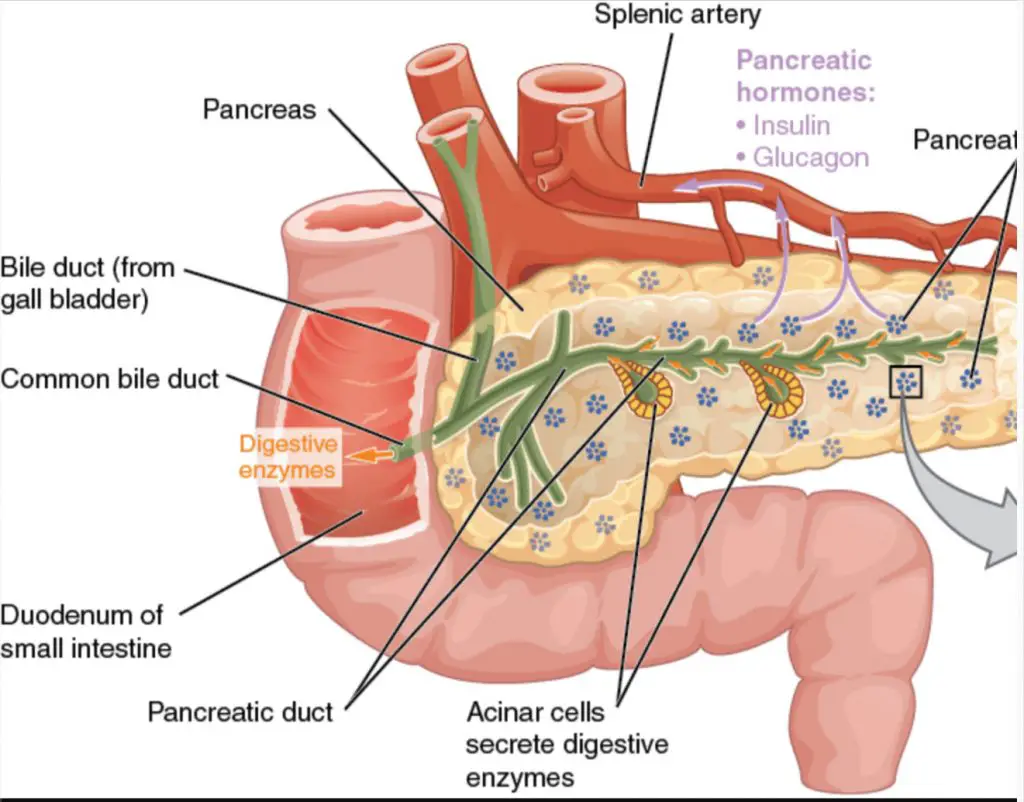Does the pancreas Produce bile? & Why bilirubin is affected in pancreatic diseases.
Our content is not intended nor recommended as a substitute for medical advice by your doctor. Use for informational purposes only.
The pancreas doesn’t produce bile. Instead, bile is formed inside the liver, stored in the gallbladder, and excreted to the duodenum through the bile duct.
Today, we will discuss some basic facts and answer questions about the pancreas, bile problems, and the link between them.
Does the pancreas produce bile?
The pancreas is not responsible for producing bile; bile reaches the digestive tract from the liver through the common bile duct.
The pancreas is not involved in any step of bile production. However, some pancreatic diseases may alter bile levels in your body.
Bile passes from the liver through the common bile duct. The common bile duct units with the pancreatic duct near its end form a common duct called (the ampulla of Vater).
So, biliary and pancreatic secretions are secreted into the duodenum through a common channel (the ampulla of Vater).

What does the pancreas produce?
The pancreas has two main functions:
A. Exocrine function:
The pancreas secretes all the essential digestive enzymes necessary for food digestion. The enzymes are formed inside pancreatic cells and then pass through the pancreatic ducts to the duodenum.
Common digestive enzymes secreted by the pancreas include:
- Lipase enzyme for fat digestion.
- Amylase enzyme for carbohydrate digestion.
- Trypsin and chymotrypsin enzymes for protein digestion.
These digestive enzymes become mixed with pile at the ampulla of Vater and then pass into the duodenum.
The bile and digestive enzymes mix with food at the duodenum and play a major role in digesting and absorbing food constituents.
B. Endocrine function.
Other cells of the pancreas produce substances called (hormones) directly into the bloodstream (not through the pancreatic ducts).
Common hormones secreted by the duodenum include:
- Insulin hormone helps your body’s cells to use glucose to produce energy.
- Glucagon hormone helps raise your blood glucose levels when they become low.
What produces bile in the body?
The bile is an end product of hemoglobin (a complex molecule that carries the oxygen inside red blood cells).
Hemoglobin inside the RBCs breaks down into a substance called the biliverdin. Biliverdin is then processed inside the liver cells into bilirubin (bile).
Bile is collected through a small intrahepatic bile canaliculi network from the liver cells. Then, bile is excreted into the gallbladder, where it stays to be secreted the next time you eat.
After you eat, the gallbladder contracts to secrete bile into the duodenum through the common bile duct (which units with the pancreatic duct to open in the second part of the duodenum).
So, The pancreas doesn’t produce bile; the liver does. However, the bile and pancreatic juice become mixed before reaching the duodenum.
Why is bilirubin affected in some pancreatic diseases?
Some diseases and conditions may cause blockage of the ampulla of Vater, leading to obstruction of both pancreatic and bile outflow.
Common conditions include:
- Gallstone pancreatitis: when a small stone obstructs the opening of the bile duct and the pancreas in the duodenum (at the sphincter of Oddi).
- Cancer head of the pancreas: the common bile duct and the ampulla of Vater.
- Tumors at the opening of the pancreatic and common bile duct (ampullary cancer and papillary tumors of the duodenum).
The obstruction of both pancreatic and biliary ducts eventually leads to symptoms of acute pancreatitis and symptoms of obstructive jaundice.
Symptoms of combined pancreatic and biliary obstruction:
A. Symptoms of acute pancreatitis.
- Severe persistent pain in the upper central abdomen that radiates to the back.
- The pain is often severe dull, aching, and radiates to the mid-back.
- Nausea, vomiting.
- Diarrhea or constipation.
- Anorexia.
- It may be fever, headache, dizziness, or coma.
B. Symptoms of biliary obstruction.
- Biliary colic: attacks of sudden severe right upper quadrant pain that radiates to the right shoulder and the right back.
- The attack often lasts for several hours and may occur more than once per day.
- Jaundice (yellowish skin and eye whites).
- Pale or clay stools.
- Dark (tea-colored) urine.
- Severe nausea and vomiting (particularly during the attack).
- Evidence-based
- Written by a doctor.












